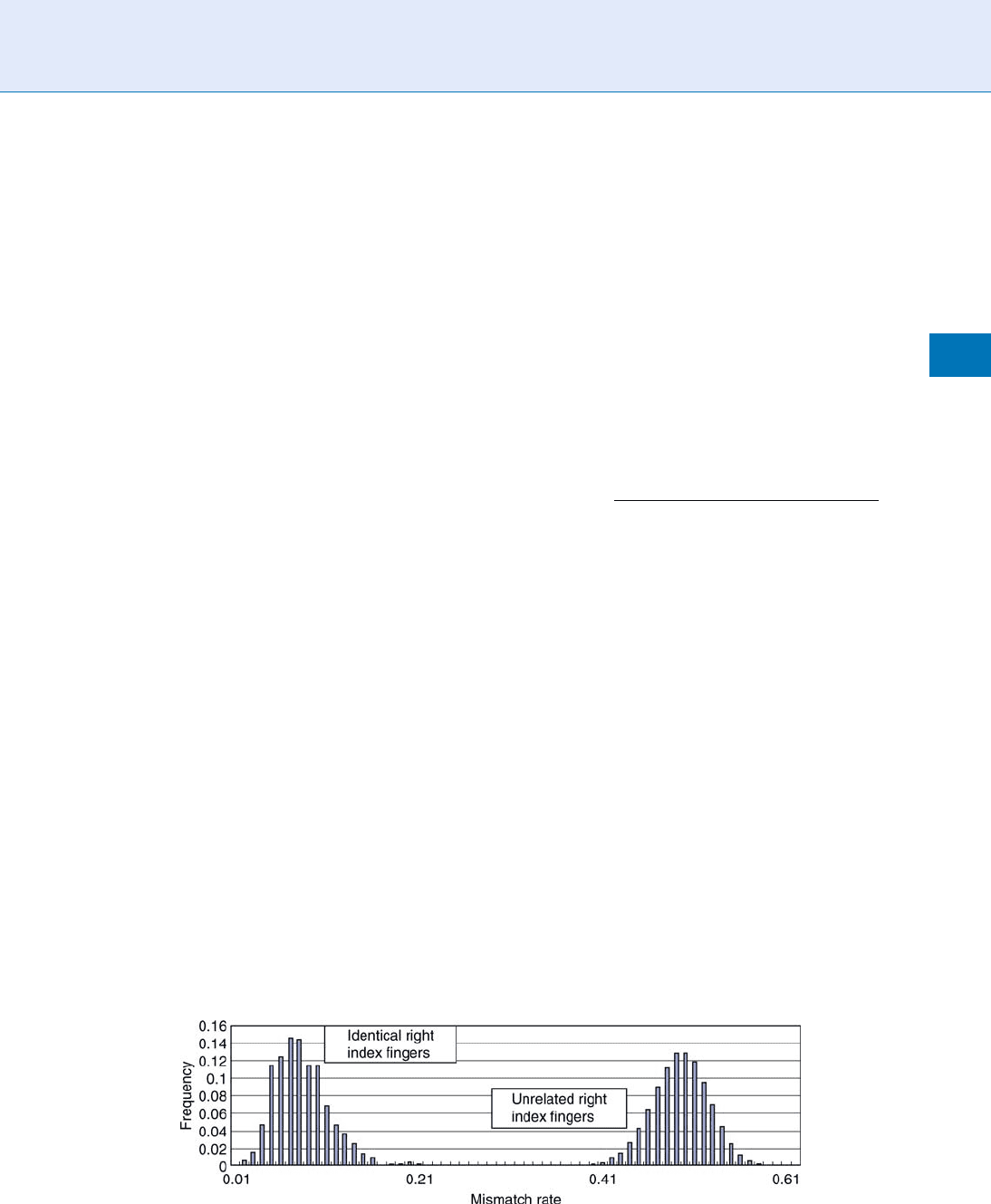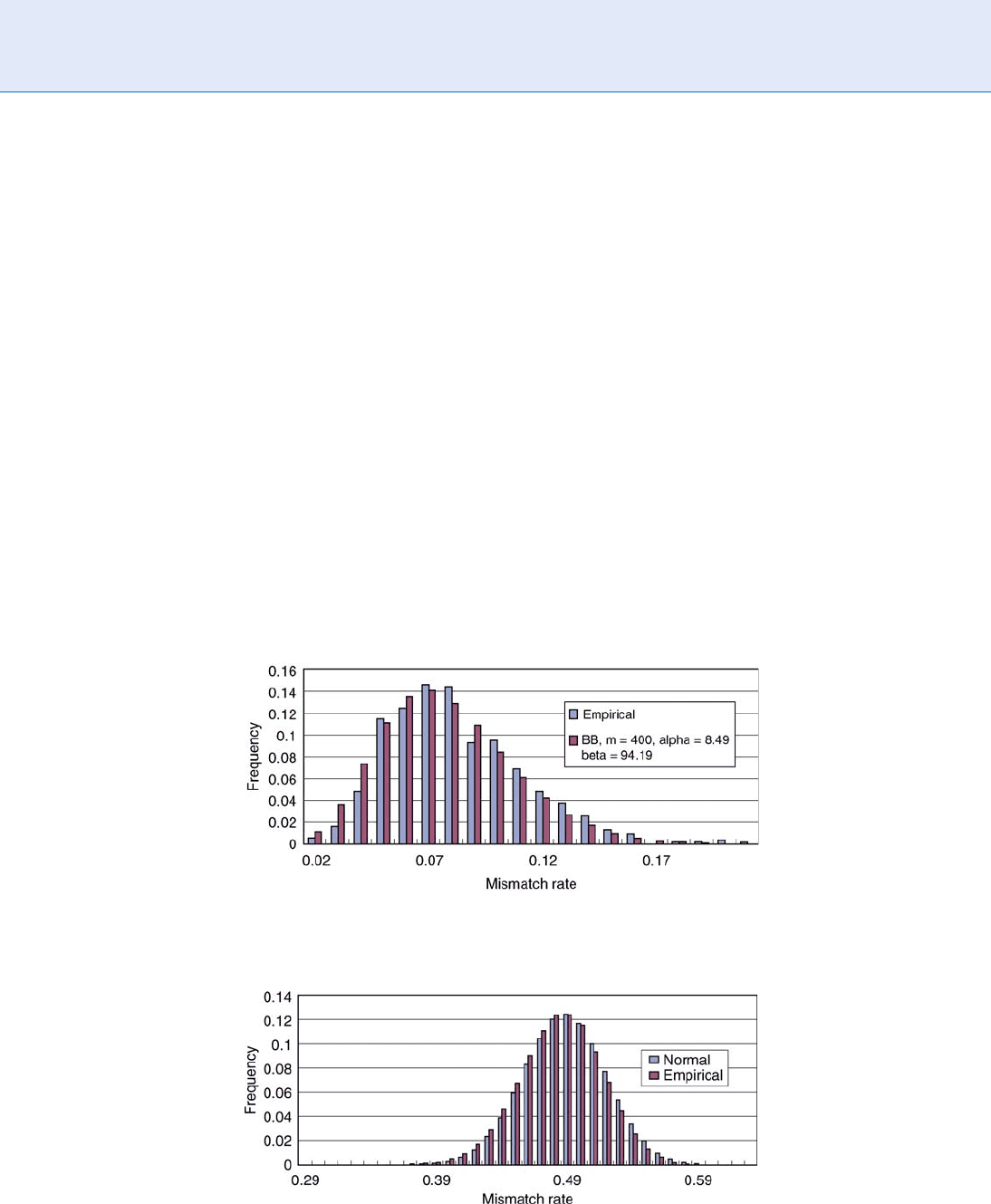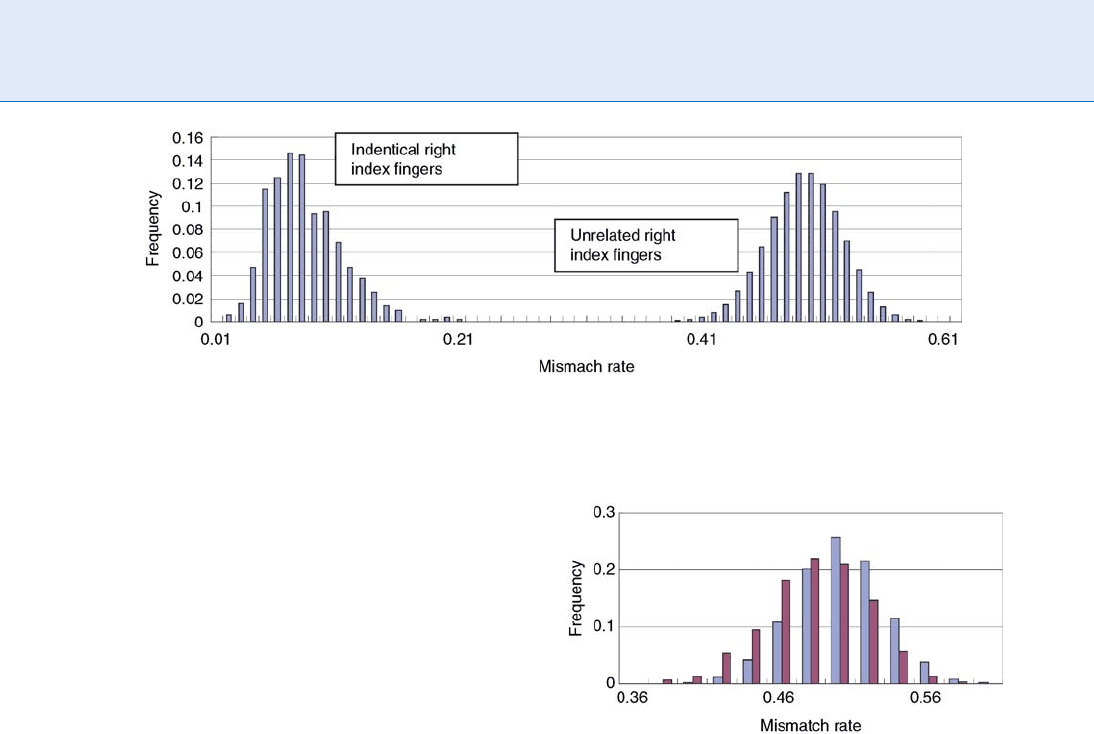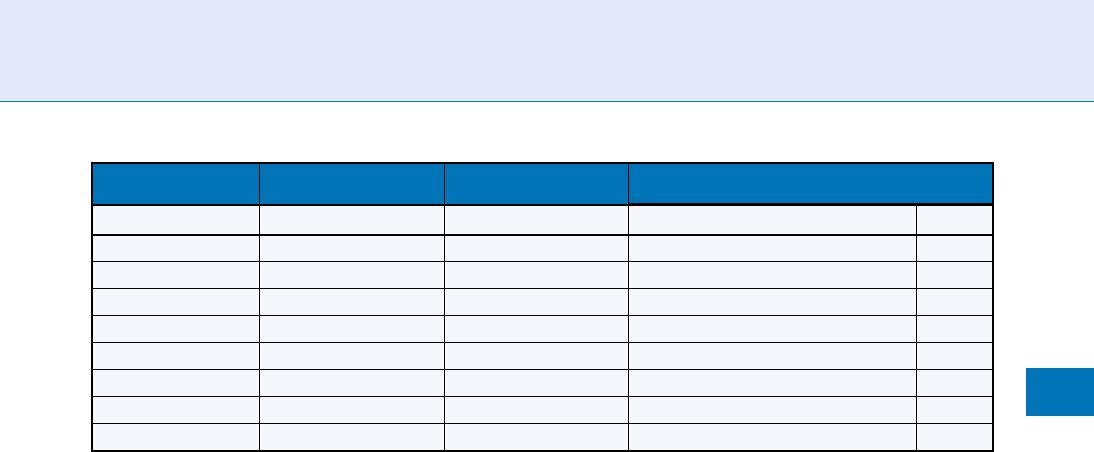Li S.Z., Jain A.K. (eds.) Encyclopedia of Biometrics
Подождите немного. Документ загружается.


body. Since most of the hemoglobin of human body
exists in red blood cells that are flowing inside blood
vessels, the blood vessel network patterns can be seen
as a dark area by infrared imaging systems. Vascular
network patterns inside finger of an individ ual are
visualized by utilizing this optical characteristic of he-
moglobin. Therefore the network patterns can be used
as a biometric modality by appropriate imaging tech-
nologies. As the diameters of arteries are as small as
approximately 1/3 of those of targeted veins in finger,
it is reasonable to assume that most of the visualized
blood vessels are veins. This is why many of vascula r
biometric technologies are known as ‘‘vein’’ biometrics,
though arteries and veins are equally visualized by
infrared light and normally treated in the same manner.
Kono et al. developed a near-infrared finger vein
reader prototype and demonstrated its effectiveness in
2000 [1], and further evaluated the performance of the
proposed biometric modali ty by using sample data
collected from 678 subjects and reported very positive
results in 2002 [2].
There are two major approaches to visualize vascu-
lar patterns for biometric use, name ly the light pene-
tration method and the light reflection method. The
light penetration method utilizes the infrared light
transmitted through the target object, while the light
reflection method makes use of the light reflected by
the target. The light reflection method is not usually
the first choice unless it is necessary because it is
difficult to handle the reflected images that may con-
tain saturated (over-exposed) areas or texture on the
skin surface. The contrast of the images captured by
penetrating light is generally higher than that captured
by reflected light. The high contrast images result in
high accuracy of authentication because more infor-
mation to distinguish the network patterns can be
extracted from the high signal to noise ratio image.
However, the light reflection method is only a choice in
case of imaging thick target objects such as palm vein
or the back-of-the-hand vein in which near infrared
rays are not transmitted through the body. Fingers are
only parts of a human body which can be easily pre-
sented to an authentication device, and from which
clear pattern images can be captured by using ‘‘light
penetration method.’’ Therefore, finger vein biometrics
is recognized as one of the most reliable and stable
biometric modalities.
Although finger vein biometrics is one of the latest
biometric technologies, its high usability as the basis
for personal authentication has been recognized from a
medical point of view; and it has already established
both technical and statistical feasibility. In the follow-
ing sections, medical opinions describe how the finger
vein conforms to three desirable properties for
biometrics. The uniqueness of Finger Vein was also
evaluated in statistical approach.
Medical Opinions Concerning
Finger Vein Authentication
Technology
In 2006, Central Research Laboratory, Hitachi, Ltd.
(Tokyo, Japan) [3] and Hitachi-Omron Terminal Solu-
tions, Corp. (Tokyo, Japan) [4] held a series of four
Finger Vein Authentication Workshops, which was
attended by representative Japanese researchers. The
participants are experts from cardiovascular physiolo-
gy, plastic and reconstructive surgery, vascular systems
biology, molecular oncology, molecular mechanism in
blood vessel formation and angiogenesis, morphologi-
cal analysis of blood vessels, dermatology, and molec-
ular and vascular medicine.
Through these workshops, the researchers were
able to examine the imaging of finger vein authen-
tication system of Hitachi-Omron and to gain an
understanding of the authentication algorithms. The
workshops were an opportunity to obtain from
researchers several improvement medical opinions
concerning finger vein authentication technology that
are set forth below.
a) Universalit y
Veins and arteries are essential for circulating
oxygen and nutrients to the finger tissues, and it is
Finger Vein. Figure 1 Extracted finger vein image.
420
F
Finger Vein

a fact known to medical science that the approxi-
mately 0.3–1.0 mm thick vein in the skin surface
layer that is targeted for the authentication basically
exists in all people.
b) Uniqueness
In ontogenesis, the patterning of the vascular
network undergoes change from its initial state,
and the arteriovenous network is formed subject
to the effects of low oxygen and blood flow. This
process takes place under genetic constraints, but is
not deterministic; it includes many probabilistic
elements. Thus, there will be large individual dif-
ferences in the pattern of the vein that is used for
authentication, and its utility as the basis for per-
sonal authentication will be high.
c) Permanence
The basic pattern of the blood vessels is formed
during the fetal stage. Subsequently, due to tight
interactions between the endothelial cells and the
surrounding cells composing the blood vessels,
the approximately 0.3–1.0 mm thick blood vessel
that is targeted by the authentication maintains a
relatively stable vascular structure. In addition, the
blood vessel targeted by the authentication is as-
sured of a permanent flow of blood, and in healthy
adults it is extremely unlikely to be lost with aging.
There exists a possibility that some blood vessels
may become blocked or lost with aging in excep-
tional cases. Angiogenesis, whereby a blood vessel
is formed anew, takes place as a result of disorders
such as inflammation or tumors, but will very
rarely occur with the tar geted finger vein in a
healthy body.
d) Racial/ethnic differences
No large racial or ethnic variations are known in
the patterns relevant for personal identification.
Uniqueness in Statistical Approach
In 2007, Yanagawa et al. demonstrated the diversity
of human finger vein patterns by conducting statisti-
cal analysis based on sample data collected from
506 subjects. They also proved the feasibility(reliabil-
ity) of using finger vein patterns for personal identi-
fication by evaluating false acceptance rates (FAR)
and false rejection rates (FRR) based on mathematical
models [5].
a) Diversity of finger vein patterns
Finger vein authentication uses MisMatch Rate
(MMR) to decide whether vein pattern s are identi-
cal or not. MMR is defined as
MMR ¼
total number ofmismatched pairs
total number of pixels classified into
vein in the tw o finger patterns
Figure 2 shows histograms of the MMR com-
puted from 1,012 (= 506 person 2) pairs of
identical right index fingers and 255,530 (= 506
505) pairs of unrelated right index fingers. The
figure shows that two histograms are separated,
indicating the significant difference of vein patterns
of the right index finger between individuals. The
histograms of MMR derived from the pairs of
unrelated right index fingers are almost overlapped
with other pair combinations; a right index finger
and a right middle finger of an identical person, a
right index finger and a left index finger of an
identical person. These observations indicate that
two fingers are identical if and only if they are the
same finger in the same hand of the same person,
and all the other cases can be treated simply as
unrelated.
Finger Vein. Figure 2 Histograms of mismatch rates computed (MMR) from 1,012 pairs of identical right index
finger and 255,530 pairs of unrelated index finger.
Finger Vein
F
421
F

b) Reliability estimation of personal identification by
mathematical models
The validity of our personal identification is
evaluated by two probabilities inherent to the de-
vice, the FRR and the FAR. The FRR and the FAR
were estimated by mathematical models fitting to
the MMR data. Figure 3 shows the histograms of
MMR computed from identical right index fingers
(empirical 1,012 pairs) and fitted beta-binominal
distribution, demonstrating the fitting is fairly
good. Figure 4 shows the histogram from
2,540,120 unrelated pairs (empirical). The histo-
gram and the normal distribution N(0.4859 ,
0.03082) shows pretty good correspondence.
Table 1 shows the estimated FRR and FAR from
the beta-binominal distribution and the normal
distribution respectively for selected values of the
cut-off points. For example, the FRR is 3.16E-6 and
the FAR is 1.31E-12 at the cut-off point of 0.270
on the table while the FRR is 1.0E-4 and the FAR
is 1.0E-6 in the official accuracy specification of
actual authentication products. Accordingly, finger
vein pattern itself has potential to achieve quite
high accuracy.
Summary
Today, finger vein biometrics is recognized as one of
the most reliable and secure biometric modalities and
is applied to a variety of security systems. As described
here, it has already established both of statistical feasi-
bility and its high usability as the basis for personal
authentication is recognized from the point of view of
the medical opinions. The FRR derived from the math-
ematical models fitted to the empirical histograms is
1.31E-12, while the official FAR of the current finger
vein authentication products is 1.0E-6. Accordingly,
finger vein pattern itself has the potential to achieve
quite high accuracy. Unlike conventional biometric
features such as finger print, vascular network patterns
cannot be observed without using specially designed
Finger Vein. Figure 4 Histograms of mismatch rates (MMR) computed from 2,540,120 unrelated pairs of right index
finger (empirical) and normal distribution with mean = 0.4859 and s.d. = 0.0308.
Finger Vein. Figure 3 Histograms of mismatch rates (MMR) computed from 1,012 pairs of identical right index
finger (empirical) and Beta-Binomial distribution with m = 400, a = 8.49 and b = 94.19.
422
F
Finger Vein

equipment, and thus it is extremely difficult to steal or
duplicate the biometric information. Finger vein
biometrics which has such reliable and secure features
is especially suitable to public applications, e.g., bank-
ing system s, medical systems, and passport controls.
Its banking applications (Fig. 5) remain one of the
largest and the most successful set of applications for
this state-of-the-art biometric modality; and it is
anticipated that more than a quarter of ATMs in
Japan will be equipped with finger vein readers by the
end of 2008.
Related Entries
▶ Finger Vein Feature Extraction
▶ Finger Vein Imaging
▶ Finger Vein reader
▶ Hand Veins
References
1. Kono, M., Ueki, H., Umemura,S.: A new method for the identi-
fication of individuals by using vein pattern matching of a finger.
In: Proceedings of the Fifth Symposium on Pattern Measure-
ment (Yamaguchi, Japan), pp. 9–12 (2000) (in Japanese)
2. Kono, M., Ueki, H., Umemura, S.: Near-infrared finger vein
patterns for personal identification. Appl. Opt. 41(35),
7429–7436 (2002)
3. Hitachi Central Research Laboratory, http://www.hitachi.
comfrd/cr//
4. Hitachi-Omron Terminal Solutions, Corp., http://www.hitachi-
omron-ts.com/index.html
5. Yanagawa, T., Aoki, S., Ohyama, T.: Human finger vein images
are diverse and its patterns are useful for personal identification.
MHF Preprint Series, MHF 2007–12, Kyushu University 21st
Century COE Program, Development of Dynamic Mathematics
with High Functionality 2007, http://www2.math.kyushu-u.ac.
jp/coe/report/pdf/2007-12.pdf
6. Jain, A.K., Bolle, R., Pankanti, S.: Biometrics: Personal Identifi-
cation in Networked Society. Kluwer Academic Publishers, Dor-
drecht, The Netherlands, 1999
Finger Vein. Table 1 Estimated false acceptance rate (FRR) and false rejection rate (FAR)
Cut-off point FRR FAR 95% c.i. Of FAR
0.270 3.16E-06 1.31E-12 6.32E-13 2.56E-12
0.275 2.03E-06 4.10E-12 2.07E-12 7.80 E-12
0.280 1.30E-06 1.25E-11 6.41E-12 2.45 E-11
2.285 8.23E-07 3.73E-11 2.00E-11 6.96 E-11
2.290 5.20E-07 1.08E-10 5.82E-11 1.94 E-10
2.295 3.27E-07 3.07E-10 1.74E-10 5.49 E-10
0.300 2.04E-07 8.47E-10 4.84 E10 1.46 E-09
0.305 1.27E-07 2.28E-09 1.35E-10 3.85 E-09
3.310 7.86 E-08 5.97E-09 3.69E-11 9.81 E-09
Finger Vein. Figure 5 ATM equipped with a finger vein reader (Courtesy of Hitachi-Omron Terminal Solutions, Corp.).
Finger Vein
F
423
F

Finger Vein Authentication Device
▶ Finger Vein Reader
Finger Vein Biometric Algorithm
MIT SUTOSHI HIMAGA
Hitachi-Omron Terminal Solutions, Corp. Tokyo,
Japan
Synonym
Finger vein feature segmentation
Definition
Finger vein biometric algorithm is a series of software
processes to authenticate a person by using biome tric
features extracted from his or her finger vein patterns.
The algorithm is typically comprised of two major
processes, namely, a finger vein feature extraction
part and a matching algorithm part.
Introduction
Finger vein feature extraction, along with finger vein
imaging technology, is a core technolog y in finger
vein authentication. By applying this process, a simple
▶ raw finger vein image is converted into meaningful
biometric data that can be used to identify a person.
The finger vein feature extraction is executed in both
the enrollment process and the authentication process
of a finger vein biometric system. In the enrollment
process, the extracted biometric data is used to create
template data together with the associated personal
information such as username or identification num-
bers. In the authentication process, the finger vein
feature extraction is applied to each frame of the
scanned image prior to the matching process with the
pre-registered template data.
The selection of the biometric features is dependent
on the extraction algorithm, and therefore, the features
extracted by one algorithm can be very different from
those extracted by another, even for an identical finger.
This means that a template produced by one finger
vein system may not be compatible with another.
There are multiple manufacturers who have commer-
cialized finger vein authentication systems; however,
the compatibility of finger vein templates is not guar-
anteed in many cases.
Requirements for the Finger Vein
Biometric Algorithm
Unlike other biometrics such as finger print, finger vein
patterns do not leave any trace and can only be observed
by using a purpose-made imaging device. This makes it
extremely difficult to steal or duplicate the biometric
features, which comprises one of the many reasons to
use this biometric modality. On the other hand, from
technical point of view finger vein biometrics requires
some special image processing technology that enables
the system to extract clear and stable biometric features.
Since the quality of raw images of intra-body structure is
generally very poor, a sophisticated illumination control
and image processing technology is required. In other
words, quite of lot of technical know-how is necessary
to extract high quality biometric features from such
low quality images that have a large individual variation.
Considering the variety of the know-how, it is quite
reasonable to assume that there are many implementa-
tions of finger vein biometric algorithms. The compati-
bility of the biometric information (i.e., templates)
is, however, largely dependent on the biometric algo-
rithm and, therefore, it is very important to design the
algorithm so that the template can be widely applicable
to a variety of applications.
Finger Vein Feature Extraction
As described in the previous section, the details of the
finger vein feature extraction are not publicly available
due to its secure nature as of the time of writing.
However, there are a few technical papers reported by
the leading manufacturer, Hitachi, Ltd. (Tokyo, Japan)
[1]. One of the earliest finger vein feature extraction
algorithms developed by the Central Research Labora-
tory (CRL) of Hitachi, Ltd. is briefly introduced in the
below section [2].
424
F
Finger Vein Authentication Device

The finger vein feature extraction process is as
follows.
Step 1: Set a starting point.
An initial point is set at random within the area
inside the finger.
Step 2: Set a group of candidate pixels for the next
point.
A group of candidate pixels are selected from the
neighborhood of the initial point by using a weighted
random number. Considering the blood vessel paths, the
weighting coefficients are configured by experiment so
that horizontally connected pixels are more likely to be
selected than vertically or diagonally connected pixels.
Step 3: Find the darkest path
All candidate pixels selected in Step 2 are tested to
find the darkest direction. Each candidate point is
evaluated by analyzing the intensity difference between
the brightest pixel and the darkest pixel along the
intensity profile orthogonally crossing to the vector
made by the current pixel and the candidate pixel.
Step 4: Update the score
If the selected candidate pixel in Step3 has never
visited during the current pass, the score of the candi-
date point is increased and the current point is moved
to the candidate pixel. If the selected candidate pixel
has ever visited or no pixel was selected in Step 3, Step 6
can be used directly.
Step 5: Go back to Step 2
Step 6: Repeat Step 1–4 for 3,000 times.
After repeating this process for 3,000 times, a map
of the scores is created. As the above-mentioned algo-
rithm traces the bottom of the intensity profile, or in
other words, the darkest part within the area of the
finger vein network, highly-scored pixels tend to be
found in the middle of the blood vessels. Figure 1
shows the score map created by this algorithm. The
score is normalized by the factor of 255 so that the map
can be interpreted as an 8-bit greyscale image.
CRL introduced another finger vein feature extrac-
tion algorithm in 2002 [3], which is very different from
the above algorithm.
Matching Algorithm
The matching algorithm for finger vein biometrics can
also be implemented in many ways. A matching algo-
rithm evaluated by Yanagawa et al. [4] is briefly
described below as an example.
Yanagawa et al. published one of the very few tech-
nical papers in 2007 that describe a method to evaluate
the similarity between the two finger vein patterns, in
which they proved the feasibility of using finger vein
patterns as biometric features from a statistical point of
view. The similarity index they used for the statistical
evaluation is as follows.
Pixels that consist of an extracted vein pattern are
classified into three categories, namely, VEIN, AMBIG-
UOUS, and BACKGROUND. A pair of finger vein
patterns to be evaluated is overlapped and compared
pixel-by-pixel. If a pixel belongs to VEIN in the first
pattern corresponds to a pixel belongs to BACK-
GROUND in the second pattern, the pair of pixels is
regarded to be mismatched.
The mismatch rate (MMR) is defined as:
MMR ¼
The total number of mismatched pairs
The total number of pixels classified into
VEIN in the two finger vein patterns
It is noted that MMR is not a symmetric index. Since
pixels belonging to AMBIGUOUS and BACKGROUND
in the first pattern are excluded from the calculation,
the number of mismatched pairs varies depending
on which pattern is regarded as the first pattern. Sup-
pose a pair of finger vein patterns, R and L, have
Finger Vein Biometric Algorithm. Figure 1 Visualised finger vein network (left) and its segmented pattern (right).
Finger Vein Biometric Algorithm
F
425
F

three corresponding pixels that are classified into
AMBIGUOUS, VEIN, BACKGROUND and AMBIG-
UOUS, VEIN, VEIN, respectively, then there are no
mismatched pairs when R is selected as the first image,
while one mismatched pair is counted when L is select
as the first image.
In order to evaluate the feasibility of using finger
vein as a biometric feature, Yanagawa et al. collected
finger vein patterns from 506 subjects (405 males and
101 females). They obtained mu ltiple instances of
index and middle finger vein pattern from each subject
and compared them with the MMR value distributions
of identical and non-identical vein pattern pairs.
Figure 2 shows the histogram of the MMR values
calculated from the 1,012 pairs of identical right index
fingers (i.e., 506 subjects 2) and 255,530 unrelated
pairs of right index fingers (i.e., 506 505). The figure
shows that peaks of the two histograms are clearly
separated, which indicates the significant inter-subject
difference of finger vein patterns.
Figure 3 shows the histograms of MMR computed
from 255,530 pairs of right middle fingers and right
index fingers from identical person (dark bars) and
255,530 pairs of unrelated right index fingers (bright
bars). The figure shows that two histograms are almost
overlapped, indicating that the intra-subject differ-
ences of finger vein pattern are not signific antly larger
than inter-subject differences.
Table 1 shows the performance of MMR-based
finger vein biometrics in terms of FAR and FRR.
Yanagawa et al. estimated the FAR and the FRR based
on the fitted normal distribution and the fitted beta-
binominal distribution, respectively. They successfully
demonstrated the supreme characteristics of biometrics
by illustrating the two indices over several cut-off points
(threshold values) together with 95% confidence inter-
vals of the FAR. The figures in Table 1 are particularly
better than the publicly announced FAR and FRR values
of commercial products; at the cut-off point of 0.270 for
instance, the statistical analysis indicates that the esti-
mated FAR and FRR are as low as 1.31E-12 and 3.16E-6,
respectively. These figures are far lower than the claimed
FAR (1.0E-6) and FRR (1.0E-4) of commercial pro-
ducts, which implies that the biometric feature as such
has a very preferable characteristic that can potentially
achieve even higher accuracy.
These results strongly support the feasibility of
finger vein biometrics and imply that indices such as
MMR can effectively distinguish genuine patterns from
others by applying an appropriate threshold value. The
index described here is, however, quoted solely for the
purpose of explanation, and therefore, it does not
really represent the actual finger vein matching algo-
rithm employed by commercial products.
Finger Vein Biometric Algorithm. Figure 2 Histograms of mismatch rates computed based on the right index figures.
Finger Vein Biometric Algorithm. Figure 3 Histograms
of mismatch rates computed based on the right index
fingers and middle fingers of identical person (dark) and
those of unrelated individuals (bright).
426
F
Finger Vein Biometric Algorithm

Standardization Issue
Sincetherearemanywaysofimplementationforfinger
vein biometric algorithm as described above, it is very
important to standardize the basic framework of the bio-
metric system in order to expand and guarantee the com-
patibility . There are many ongoing projects and activities
aiming to standardize various biometric modalities. One
of the most compr ehensive and widely-recognized groups
is the Sub Committee 37 (SC37) of the Joint Technical
Committee for Information Technology (JT C1) [5]. JTC1
is a joint project established by the International Organi-
zation for Standardization (ISO) [6] and the Interna-
tional Enginee ring Consortium (IEC) [7]. SC37 is
dedicated to the standardization of biometrics since
2002 and is one of the 18 active Sub Committees of the
joint project. SC37 members are all national bodies, and
there are 25 participating countries and 7 observing
countries as of October 2007. SC37 has already released
20 official standards including a standard for biometric
vascular image data published in 2007 [8].
Summary
Although finger vein biometrics is one of the latest
biometric modalities, its feature extraction algorithm
has been continuously improved since the beginning of
its fundamental research in early 1990s. The feature
extraction algorithm described in this document is
based on one of a very few academic papers reporting
the core part of the finger vein biometrics; how-
ever, it is quite possible that the feature extraction
methods employed by commercially available products
today have already been modified or totally renewed.
This continuous improvements and updates of the
algorithm are, in many cases, beneficial or even prefer-
able from a security point of view. Finger vein
biometrics is with no doubt one of the most accurate
biometric modalities available today. With its high
usability and user-acceptability, it is highly anticipated
that this new biometric technology will establish a de
facto standard of the next generation access control
system in various application fields.
Related Entries
▶ Finger Vein
▶ Finger Vein Imaging
▶ Finger Vein Reader
References
1. Hitachi, Ltd. http://www.hitachi.com/
2. Miura, N., Nagasaka, A., Miyatake, T.: Feature Extraction of
Finger Vein Patterns Based on Iterative line Tracking and Its
Application to Personal Identification. IEICE Trans. Inf.Syst.
J86-D-II(5), 678–687 (2003) (Japanese Edition)
3. Kono, M., Ueki, H., UmemuraS.: Near-infrared finger vein pat-
terns for personal identification. Appl. Opt. 41(35), 7429–7436
(2002)
4. Yanagawa, T., Aoki, S., Ohyama, T.: Human finger vein images
are diverse and its patterns are useful for personal identification
MHF Preprint Series, MHF 2007-12, Kyushu University 21st
Century COE Program, Development of Dynamic Mathematics
with High Functionality (2007)
5. The Joint Technical Committee for Information Technology:
www.jtc1.org
6. The International Organization for Standardization:http://www.
iso.org/iso/home.htm
7. The International Engineering Consortium:http://www.iec.org/
8. ISO/IEC 19794-9:2007:Information technology – Biometric data
interchange formats – Part 9: Vascular image data. (2007)
Finger Vein Biometric Algorithm. Table 1 Estimated false acceptance rate (FAR) and false rejection rate (FRR)
Cut-off point FRR FAR
95% c.i. of FAR
0.270 3.16E-06 1.31E-12 6.32E-13 2.56E-12
0.275 2.03E-06 4.10E-12 2.07E-12 7.80E-12
0.280 1.30E-06 1.25E-11 6.41E-12 2.45E-11
0.285 8.23E-07 3.73E-11 2.00E-11 6.96E-11
0.290 5.20E-07 1.08E-10 5.82E-11 1.94E-10
0.295 3.27E-07 3.07E-10 1.74E-10 5.49E-10
0.300 2.04E-07 8.47E-10 4.84E-10 1.46E-09
0.305 1.27E-07 2.28E-09 1.35E-09 3.85E-09
0.310 7.86E-08 5.97E-09 3.69E-09 9.81E-09
Finger Vein Biometric Algorithm
F
427
F

Finger Vein Feature Segmentation
▶ Finger Vein Biometric Algorithm
Finger Vein Imaging Device
▶ Finger Vein Reader
Finger Vein Pattern Imaging
MIT SUTOSHI HIMAGA
Hitachi-Omron Terminal Solutions, Corp., Tokyo,
Japan
Definition
A technology to visualize and capture an individual ’s
finger vein network patterns.
Introduction
Blood vessels are not exposed out of the human body
and its network patterns are normally impossible to see
without the range of visible light wavelength (Retinal
blood vessels are the only exception, which can be seen
in visible light. However, it is necessary to use specially
designed devices such as ophthalmoscopy or retinal
scanner to observe the blood vessels on retina.). In
order to visualize blood vessel patterns that are hidden
under the skin, it is necessary to use appropriate imag-
ing technologies. It is well known that hemoglobin
absorbs
▶ near infrared rays more than other sub-
stances that comprise human body. Since most of the
hemoglobin in human body exists in red blood cells
that are flowing inside blood vessels, the blood vessel
network patterns can be seen as dark area by infrared
imaging systems. Finger vein pattern imaging is a
technology that utilizes this optical characteristic of
hemoglobin, by which vascular network patterns inside
the finger of an individual are visualized. The raw
images taken by using infrared lights can further be
improved by appropriate illumination control and
image processing techniques such as contrast enhance-
ment so that biometric information can be extracted.
Although the same sort of technology is widely used in
medical fields (which are sometimes referred to as opti-
cal coherence tomography or OCT), the scope of this
document is limited to its biometric applications only.
Infrared lights projected in a human body can easily
be diffused and the contrast of blood vessels and the
background is rapidly deteriorated as the infrared light
penetrates deeper into the part of the body. This is
sometimes compared to a swizzle stick put in a glass
of milk. The swizzle stick can be seen from outside when
it is close to the interior surface of the glass, however, it
becomes gradually invisible when it is moved towards
the middle of the glass due to the light diffusion. There-
fore, it is believed that the vascular network patterns
visualized by infrared illumination exist in the area that
is close to the skin. Considering the resolution of the
cameras commonly used for finger vein biometrics and
the fact that the diameters of arteries are as small as
approximately 1/3 of those of veins in finger, it is rea-
sonable to assume that most of the visualized blood
vessels are veins. This is why many of vascular biometric
technologies are known as ‘‘vein’’ biometrics, though
arteries and veins are equally visualized by infrared
light and normally treated in the same manner.
Light Source
The most commonly used light source for blood vessel
pattern imaging is infrared light emitting diodes (IR-
LEDs). The IR-LED is not a newly developed product;
they are being widely used for household appliances
such as TV remote controllers for a long time, which
proves the safety for human beings and livestock. In
the actual implementation, there are many forms of
the light source arrangements depending on the target.
Finger vein imaging systems typically require small
and oblong field of view, and therefore linear arrays
of IR-LEDs are usually preferred. On the other hand,
grid or circular light source arrangements are more
appropriate for the systems that require larger field of
view. Many of palm vein and back-of-hand biometric
systems employ this type of light source configuration.
428
F
Finger Vein Feature Segmentation

Illumination Control
Finger vein patterns are distinct from other biometric
features as they are inside human body and unnotice-
able. This is, of course, one of the major advantages of
the biometric modality, however, it is also a big chal-
lenge to capture a clear finger vein image. Since the
finger vein network has a three-dimensional structure,
some parts are close to the skin surface and others are
not. This makes it very difficult to obtain high and
homogeneous image contrast throughout the region of
interest. Furthermore, the thickness of finger has a
large individual variation, which results in a variety
of distances between the finger and the LED arrays.
Therefore, it is almost obvious that there is no single
perfect illumination setting that accommodates all
these variations and this is why the illumination con-
trol technolog y is considered to be one of the key
factors of the finger vein biometrics.
At the time of authentication process, it is virtually
impossible to obtain an image that is pixel-w ise iden-
tical to the enrolled pattern due to the differences
caused by the change in environment or the position-
ing of the sample. If only one sample image is to be
matched to the template per attempt, it is likely to have
very high false rejection rate (FRR). In order to cope
with this difficulty, most of vein biometric systems
continuously capture the presented sample with sev-
eral illumination configurations. Each of the captured
vein patterns is matched to the template one by one in
real time, and the system continues this loop until the
presented sample is either accepted or rejected. There-
fore, it is very importan t to design the illumination
control algo rithm to produce optimized images as
quickly as possible so that genuine attempt can be
processed in a short time. The details of the illumina-
tion control algorithms are, however, confidential in
most cases, and not published by any vendors at the
time of writing.
The Imaging Methods
There are two major approaches to visualize vascular
patterns for biometric use, the light penetration meth-
od and the light reflection method. The light penetra-
tion method utilizes the infra red light transmitted
through the target object, while the light reflection
method makes use of the light reflected by the target.
The light reflection method is not usually a first choice
unless it is necessary (e.g., retinal blood vessel patterns)
because it is difficult to handle the reflected images that
may contain saturated (over-exposed) areas or texture
on the skin surface. The contrast of the images cap-
tured by penetrating light is generally higher than that
by reflected light; and therefore, most commercially
available finger vein biometric sy stems employ the
light penetration method.
We will focus on the finger vein imaging technolo-
gies based on the light penetration method in this essay.
There are three major implementations of the fin-
ger vein imaging system. In the following part of this
essay, the three finger vein imaging systems are briefly
reviewed in chronological order along with some
examples of its commercial products and applications.
Top-lighting Systems
Finger vein readers whose infrared light source is
placed on the other side of the camera with respect to
the finger are called top-lig hting systems. Hitachi Cen-
tral Research Laboratory (Tokyo, Japan) [1] started the
research and development of finger vein biometrics in
mid-1990’s [2] and evaluated the technology by using a
prototype of this lighting system (Fig. 1). As illustrated
in Fig. 2, infrared rays are projected from the opposite
side of the infrared camera with respect to the sample
finger, which visualize the finger vein patterns on the
camera side.
Finger Vein Pattern Imaging. Figure 1 Finger vein
imaging systems(prototype) (Courtesy of Hitachi, Ltd.).
Finger Vein Pattern Imaging
F
429
F
